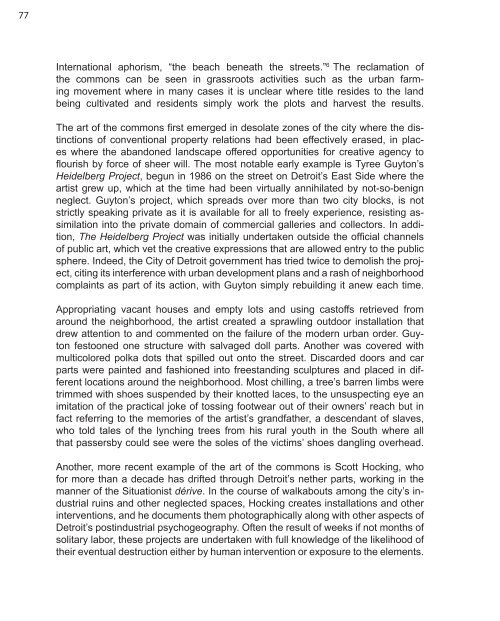Detroit Research Volume 1
You also want an ePaper? Increase the reach of your titles
YUMPU automatically turns print PDFs into web optimized ePapers that Google loves.
77<br />
International aphorism, “the beach beneath the streets.” 6 The reclamation of<br />
the commons can be seen in grassroots activities such as the urban farming<br />
movement where in many cases it is unclear where title resides to the land<br />
being cultivated and residents simply work the plots and harvest the results.<br />
The art of the commons first emerged in desolate zones of the city where the distinctions<br />
of conventional property relations had been effectively erased, in places<br />
where the abandoned landscape offered opportunities for creative agency to<br />
flourish by force of sheer will. The most notable early example is Tyree Guyton’s<br />
Heidelberg Project, begun in 1986 on the street on <strong>Detroit</strong>’s East Side where the<br />
artist grew up, which at the time had been virtually annihilated by not-so-benign<br />
neglect. Guyton’s project, which spreads over more than two city blocks, is not<br />
strictly speaking private as it is available for all to freely experience, resisting assimilation<br />
into the private domain of commercial galleries and collectors. In addition,<br />
The Heidelberg Project was initially undertaken outside the official channels<br />
of public art, which vet the creative expressions that are allowed entry to the public<br />
sphere. Indeed, the City of <strong>Detroit</strong> government has tried twice to demolish the project,<br />
citing its interference with urban development plans and a rash of neighborhood<br />
complaints as part of its action, with Guyton simply rebuilding it anew each time.<br />
Appropriating vacant houses and empty lots and using castoffs retrieved from<br />
around the neighborhood, the artist created a sprawling outdoor installation that<br />
drew attention to and commented on the failure of the modern urban order. Guyton<br />
festooned one structure with salvaged doll parts. Another was covered with<br />
multicolored polka dots that spilled out onto the street. Discarded doors and car<br />
parts were painted and fashioned into freestanding sculptures and placed in different<br />
locations around the neighborhood. Most chilling, a tree’s barren limbs were<br />
trimmed with shoes suspended by their knotted laces, to the unsuspecting eye an<br />
imitation of the practical joke of tossing footwear out of their owners’ reach but in<br />
fact referring to the memories of the artist’s grandfather, a descendant of slaves,<br />
who told tales of the lynching trees from his rural youth in the South where all<br />
that passersby could see were the soles of the victims’ shoes dangling overhead.<br />
Another, more recent example of the art of the commons is Scott Hocking, who<br />
for more than a decade has drifted through <strong>Detroit</strong>’s nether parts, working in the<br />
manner of the Situationist dérive. In the course of walkabouts among the city’s industrial<br />
ruins and other neglected spaces, Hocking creates installations and other<br />
interventions, and he documents them photographically along with other aspects of<br />
<strong>Detroit</strong>’s postindustrial psychogeography. Often the result of weeks if not months of<br />
solitary labor, these projects are undertaken with full knowledge of the likelihood of<br />
their eventual destruction either by human intervention or exposure to the elements.





